Qualcomm Demos Snapdragon 805 & 802 at CES 2014
by Anand Lal Shimpi on January 14, 2014 6:25 PM EST- Posted in
- Trade Shows
- Qualcomm
- SoCs
- Snapdragon 805
- CES 2014
- Snapdragon 802
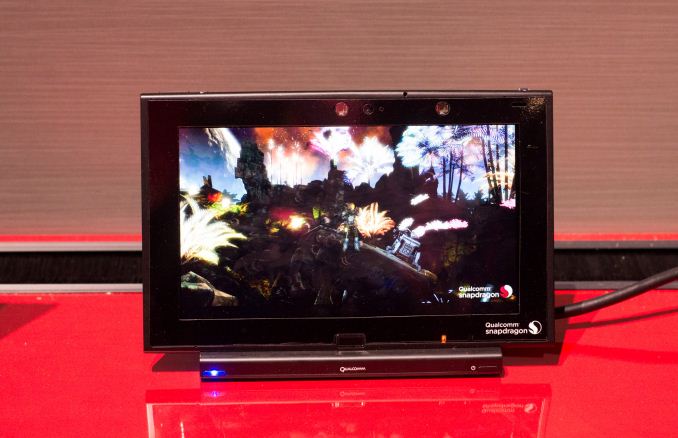
I don't know of any other mobile SoC vendor (outside of Apple) that has been able to deliver frequent, consistent architecture and product updates as well as Qualcomm. Its latest Snapdragon SoCs remain the ones to beat across all Android smartphones, and are generally found in many of the more desirable Android tablets. Last year we saw the announcement of Qualcomm's Snapdragon 805 that combines four Krait 450 CPU cores with a brand new Adreno 420 GPU, all behind a 128-bit wide memory interface. It's a pretty significant step forward at the SoC level, but particularly when it boils down to graphics. Qualcomm is promising a 40% increase in shader bound workloads compared to Adreno 330, which is pretty impressive given that we're still talking about a 28nm HPM design.
With a GPU heavy focus, Qualcomm was more than eager to show off a bunch of games running on Snapdragon 805 tablets at the show. These tablets were all running at 2560 x 1600 and had no issues delivering smooth, playable frame rates regardless of the content.
With Adreno 420 Qualcomm adds hardware tessellation, and of course had a tessellation demo at the show:
Demonstrating the additional GPU overhead offered by Adreno 420 over Adreno 330, Qualcomm had a GPU utilization monitor up on one of the systems. This test allegedly had Adreno 330 utilization at close to 100%, compared to sub-60% on Adreno 420.
Qualcomm also had Unreal Engine 3 and Unity demos, demonstrating that the company has been working closely with top tier engine providers. I fully expect the mobile GPU wars to heat up this year with Adreno 4xx from Qualcomm, mobile Kepler from NVIDIA and Apple likely moving more aggressively after the milder than expected GPU update in the A7.
Snapdragon 805 is also the first Qualcomm SoC to integrate HQV's video processing IP post acquisition, which Qualcomm promptly showed off at the show with a sequence of 1080p video upscaled to 4K. Even on the reference tablet's 2560 x 1600 resolution there's a decent quality improvement:
Good quality scaling hardware is very important, especially as tablets move to ultra high resolutions while most mobile content remains at 1080p.
Although it didn't announce any new mobile SoCs at CES last week, Qualcomm did introduce new automotive and TV SoCs: Snapdragon 602A and 802, respectively. The latter is a variant of Snapdragon 800, intended for use in TVs. Qualcomm had a reference board up and running showing off a 4K TV with a native resolution UI, driven by the SoC's Adreno 330 GPU. Qualcomm even had Riptide running, at 4K, all off of the adapted mobile SoC.
There are many believers (including NVIDIA's Jen-Hsun Huang) in the view that automotive applications of high performance mobile SoCs will be huge. You could make the same argument for high performance mobile SoCs in TVs as well. Traditionally, large amounts of user facing compute power have been kept out of both of those applications. Should that tradition stop now, the current day leaders in mobile will likely have a big advantage in entering those markets. Just as we saw in mobile however, I suspect a big part of compute being useful in cars and TVs will depend on having the right software to properly take advantage of the hardware.


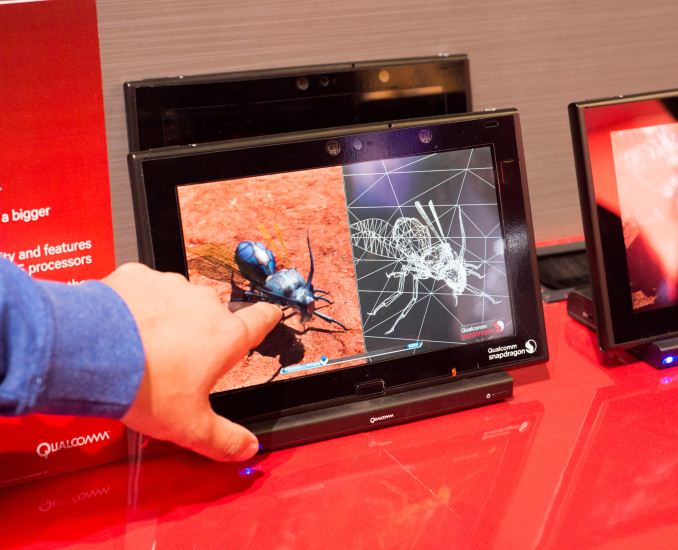
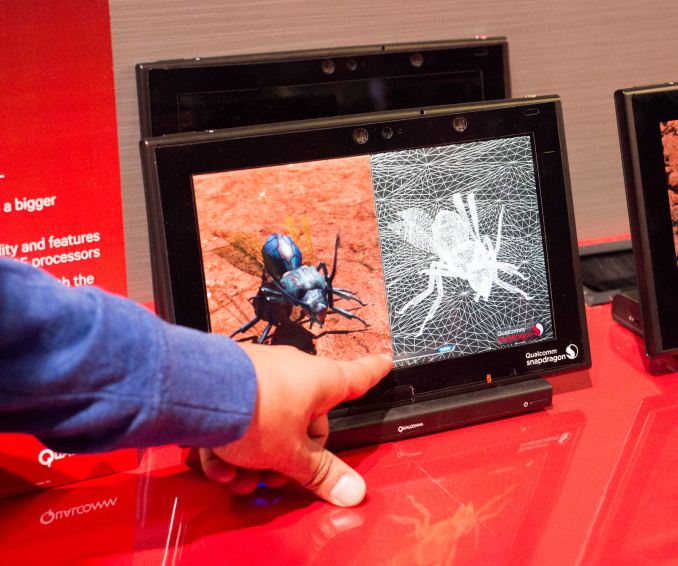
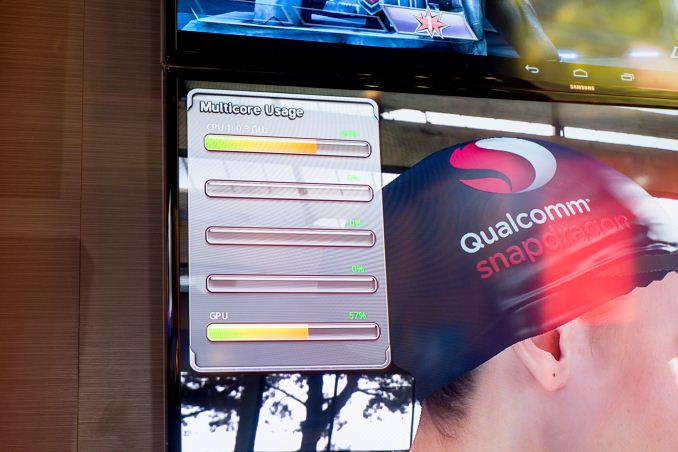
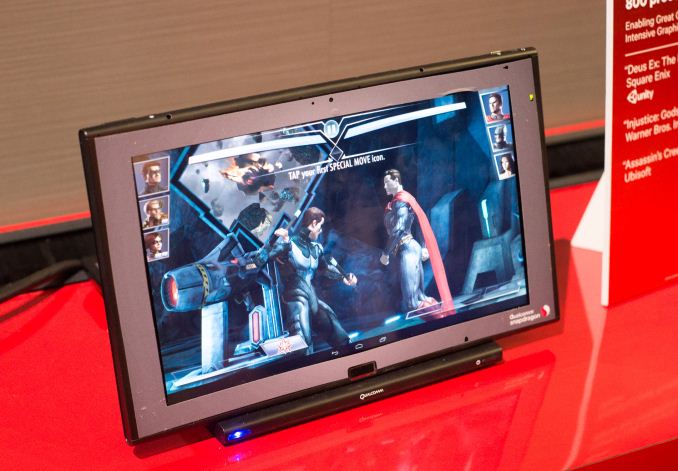
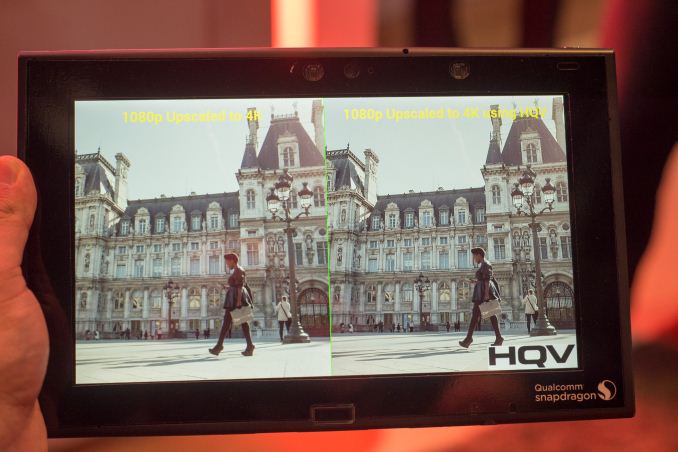














26 Comments
View All Comments
theCuriousTask - Wednesday, January 15, 2014 - link
It can make sense for apple to design their own gpu arch because their goals are different the ImagTech. They can cater purely for themselves which means they can spend more on die area and power efficiency for their design as well as have the arch coincide with their release cycle. Unlike many of their competitors, Apple is willing to pay more for their soc because they don't need to make a profit on that specific part. Hence A7.melgross - Sunday, January 19, 2014 - link
They did, years ago. But nothing came of it, as far as I know. But, Apple is intimately familiar with Imagination's IP. And since they own part of the company, it would make sense for them to type to pursue an architectural license, as I mentioned in my previous post. It very possible they may have obtained that already. Or, if not, then to add features to Imagination's own GPU that would be sold to Apple.I believe that Apple is the largest buyer of a single SoC design each year. The same one for the iPhone and iPad models. No one else sells nearly as many units of an individual model as does Apple. That gives them an advantage in discussions for a design.
mikehunt69 - Wednesday, February 5, 2014 - link
Apple have plenty of experience adding Imgtec GPUs into their SoCs, but this doesn't mean that they have the vast amount of engineering experience required to optimize or even improve a rendering pipeline. Look at how long it has taken Intel to get a handle on integrated graphics and they are CPU gods!No doubt Apple influences Imgtecs decisions when it comes to picking market segments for parts, but the cumulative years of engineering time and experience can't just be picked up by a handful of Apple engineers, regardless of whether Imgtec or anyone else would be willing to sell an architectural license.
extide - Tuesday, January 14, 2014 - link
There are also higher end SKU's avail from ImagTech, even ones in the original Series 6 lineup. I believe they are only using a 4"core" version of the GPU, and there are SKU's for up to 6 "cores".ruzveh - Wednesday, January 15, 2014 - link
By looking at the IP video up-conversion test above i can illustrate that 1080p is far superior than the converted 4k video. You can clearly see that there is a notable brightness loss in conversion to 4k video. Most of the content watched on tablets are not 1080p since there is no such 1TB & 10Tb space available in tablets, its but obvious that we would like to watch more 480p,570p or 720p which are HD, SD & Below content on them. Its important to see how they perform in those content types? I generally dont prefer conversions. Simply play in their native resolutions.colinw - Wednesday, January 15, 2014 - link
...what picture are you looking at? Both sides are being upscaled. The HQV looks much better.You would prefer to see a 480p video in a tiny little thumbnail rather than upscale it?
nathanddrews - Wednesday, January 15, 2014 - link
While HQV makes some decent scalers, I'm not convinced on this one. Contrast boosting and edge enhancement are not "improvements".twizzlebizzle22 - Wednesday, January 15, 2014 - link
Okay, I have a Nexus 5 with 1920 x 1080 or 2mp in size. If I have a 2560 x 1440 (what this years phones are heading for) screen then that's 3.6~ M. This is an 80% increase in pixels. Surely that negates the gaming performance when it's only 40% faster than the 800.I don't know about you but i'd rather stick with 1080p and have an adreno 420.
Or am I missing a trick here?
SR81 - Thursday, January 16, 2014 - link
I'm curious why not do like the consoles and render at a lower res and upscale to the phones native res.jimjamjamie - Sunday, January 19, 2014 - link
I know that I have seen some mobile games do this (or at least have the option to) already. The problem is that it looks pretty rubbish.